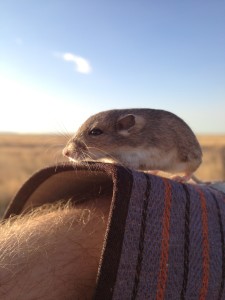“Manage the land properly and the wildlife will come,” says Dixon’s Vice President Clinton Josey in this article from the Texas Wildlife Association’s magazine. Writers Robert and Janelle Fears describe how wildlife benefits from holistic land management on Dixon’s four ranches. The article from the December 2013 issue of Texas Wildlife is republished here with permission of the Texas Wildlife Association.
North Texas Quail Corridor and Bear Creek Unit featured in Fort Worth Star-Telegram
Grazing cattle and sustaining bobwhite quail can be part of the same equation, says Kelly Reyna, our partner with UNT Quail. Reyna and our Bear Creek Unit were recently featured in this article, “Saving a Texas rite of passage, one ranch at a time,” on the North Texas Quail Corridor, an initiative to conserve this treasured but increasingly scarce game bird.
Dixon-funded research on small rodents featured in Aggie news and Big Bend Sentinel
A Dixon-funded research project by Sul Ross State University graduate student Bobby Allcorn was featured recently the Big Bend Sentinel and the Aggie News Network from Texas A&M University. Allcorn has been monitoring small rodent populations at Mimms Unit after the Rock House Fire in 2011.
Desert rodents rebound after summer rains
MARFA – Rodent researcher Bobby Allcorn had a busy September. Each week the Sul Ross State University graduate student trapped hundreds of small rodents—from petite silky pocket mice to husky wood rats—on the Dixon Ranches Mimms Unit. That’s great news for a host of other wild animals.
“The effects of the Rock House Fire, combined with the drought, devastated the small rodent population,” said Allcorn, whose research is funded by the Dixon Water Foundation, a non-profit that promotes healthy watersheds through sustainable land management. “These animals do rebound with precipitation though. And they’re coming back in force.”

While the drought persists, recent rains have been a boon to small rodents, like this silky pocket mouse found on the Dixon Ranches Mimms Unit near Marfa. (By Bobby Allcorn/Borderlands Research Institute)
In 2011, the Dixon Water Foundation partnered with Dr. Bonnie Warnock of Sul Ross’s Borderlands Research Institute to monitor the small-rodent population on the Mimms Unit. Then the historic Rock House Fire burned most of the ranch on Marfa’s northwest edge.
Without vegetation to eat or hide in, the number of mice and rats crashed, to the point that researchers rarely caught a rodent. The effects ricocheted throughout the food web, from bobcats to quail.
“Predators eat small rodents, so if there aren’t any small rodents, larger animals become prey more often,” Allcorn said. “For example, pronghorn really suffered after the fire. Not only was there no forage for them, but predators went after them more.”
Small rodents play other roles in maintaining healthy grasslands. They disperse seeds and can even alter the plant composition of an area.
“They’re a representation of overall ecological health,” Allcorn said.
Allcorn will finish his small-rodent research next year, at which point he’ll be able to draw more conclusions.
“But for now I can say the population and diversity have certainly increased since last year, due to the rainfall,” Allcorn said. “That’s a great thing for all the other animals and the environment.”
Dixon-funded research on soil microbes featured in Texas Wildlife magazine and Big Bend Sentinel
How did the Rock House Fire and 2011 drought affect soil microbes at Mimms Unit? That was the subject of a recent research project by Masahiro Ohnishi, a Natural Resource Management graduate student at Sul Ross State University in Alpine. The Dixon Water Foundation funded Ohnishi’s research, which was featured in “The Road to Recovery” in the July 2013 issue of Texas Wildlife, republished here with permission of the Texas Wildlife Association. Ohnishi’s research was featured previously in the May 16, 2013 issue of the Big Bend Sentinel.
Weatherford Democrat spotlights holistic management at Bear Creek
In Earth Day news, the Weatherford Democrat reports that our work at Bear Creek Unit “sets the standard” for environmentally sustainable ranching.
In “Managing land to protect water,” our Vice President and Board Chairman Clinton Josey describes holistic management as “treating the soil, the plants on the surface, the animals and the ranchers as a whole.”
“It’s a balance, Josey said, and when ranchers consider all the elements, it results in a healthy watershed — the area that drains to a common waterway — and a healthier life for everyone who lives in it.”
Vice President and Board Chairman Clinton Josey described as “treating the soil, the plants on the surface, the animals and the ranchers as a whole.”
It’s a balance, Josey said, and when ranchers consider all the elements, it results in a healthy watershed — the area that drains to a common waterway — and a healthier life for everyone who lives in it.
– See more at: http://www.weatherforddemocrat.com/top-news/x296817186/Managing-land-to-protect-water/#sthash.BuYR3UIe.dpuf
Dixon pledge to pronghorn recovery benefit featured in Alpine Avalanche
From the Alpine Avalanche:
The Dixon Water Foundation of Marfa and the Horizon Foundation of Dallas have pledged up to $50,000 for this weekend’s Pronghorn Restoration Benefit Dinner and Dance.
The Pronghorn Restoration Benefit is scheduled for 6 p.m. Saturday, Jan. 29, at the Granada Theater in downtown Alpine. Local landowners will serving locally grown ribeye steaks with all the fixings; a cash bar will also be available.
The program also includes a silent auction, a brief presentation on pronghorn in West Texas and an outline of the restoration plan. The evening will culminate with a dance featuring Craig Carter and the Spur of the Moment Band.
The pledge comes in the form of a challenge grant where the foundations have committed a dollar to dollar match for up to $50,000 raised during the benefit.
The benefit is spearheaded by the Trans-Pecos Pronghorn Working Group made up of local ranchers, conservationists and researchers with the Borderlands Research Institute at Sul Ross State University who are concerned with the recent demise of pronghorn in the region. Figures put the population at an all-time low of 4,800. The Pronghorn Working Group has helped implement a series of investigations into the pronghorn decline.

